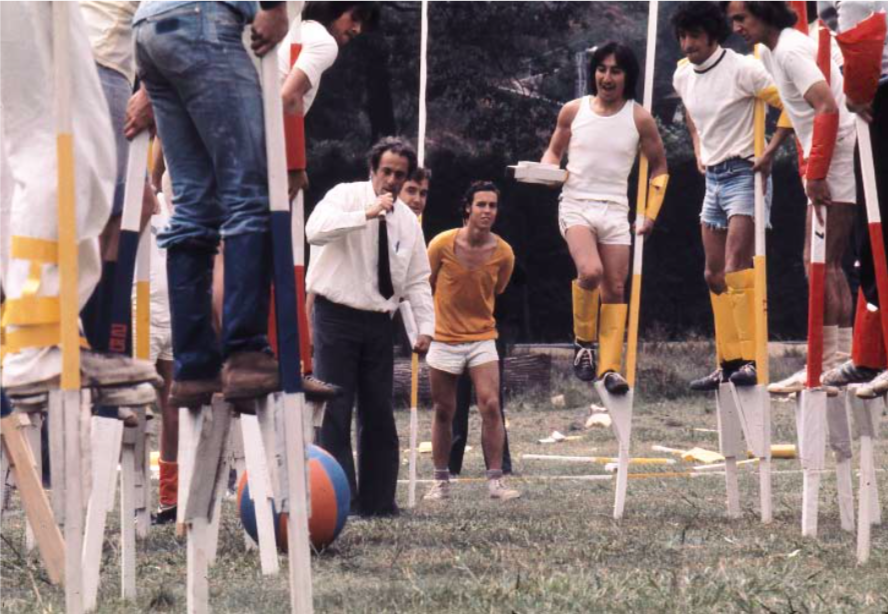The Naked School
03/21/2022
Schools must be naked, all their walls demolished to keep their structure, leaving only what is essential. They would then be buildings without facades, fully exposed to reality. They would get wet, dirty, and impregnated with their contexts; they would shake without collapsing, they would inhabit experiences that would redefine their meaning.
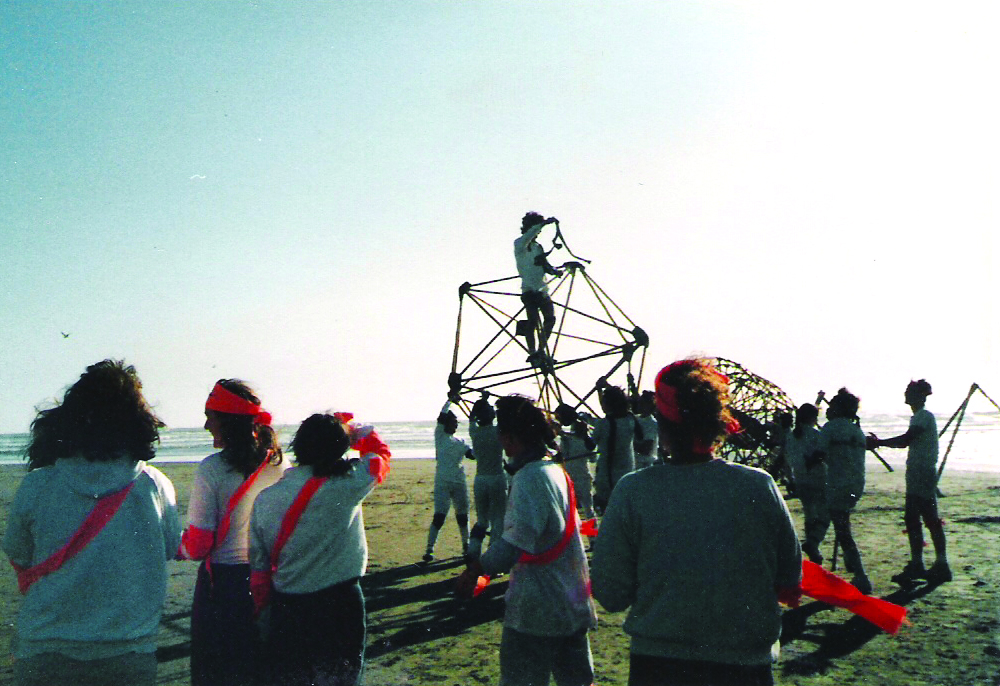
I
The Naked School is thus a proposal, put forth by the architectural metaphor of a divested building, for an imagined learning space that aims to bring education closer to the aesthetic politics of contemporary practice and the public sphere. It is a text whose ideas I began drafting during my time at the Maryland Institute College of Art, which for me was a surprising new experience. I use the word “surprising” because it is a term that fosters both wonder and disappointment. These sentiments have stimulated me to generate a text on art and education that allows me to explore my interest in the synthesis of these two fields, while also probing the relevance of these intersections in the areas of artistic social practices and participatory art. This is the crux of my work, though I don’t pretend to propose this text as a work of art, nor do I intend to inhabit the field of institutional critique.
The works produced during my two years of schooling have been developed outside of the School walls by dialoguing with its students and with other communities and territories outside the institution. Enterrar las banderas en el mar, Here We Are, Trigger, and Monumentos Horizontales are some of these projects realized between 2018 and 2020. They allowed me to bind my concerns with art and education to the premises of the Naked School. This school is the proposal of a building without walls which aims to bring artistic production closer to the social and political contexts that surround them; an approach to reality that is founded on a learning structure capable of stimulating socio-aesthetic practices inside and outside the white cube of exhibition spaces.
This text situates itself against the tendency of art schools to replicate the institutional and market-driven norms of the art world. I would argue that while art schools strive to become exhibitionary models for traditional museums and galleries, contemporary museums today seek to become schools themselves by engaging the audience with educational projects that imply a radical engagement with public space and larger audiences. From within this logic, my aim is to explore the contradiction of a self-absorbed educational system and an increasingly expansive “exhibitionary complex.”1
II
Sustaining the balance between the world that exists outside and within the academic space is one of the most complex challenges in education. Learning spaces are implanted in the interstices between theory and praxis; between the world as we know it and as we think it can become. In art, education has an even greater challenge, as it is a practice arguably without norms that inhabits extremely normative territories.
Art students are trained to be part of this system without questioning its logic. In opposition to the freedom that should be intrinsic to both art and education, learning spaces are enclosed within the walls of an increasingly disciplinary world. Art schools are physically closed buildings, filled with white walls, and blinded with spotlights to be projected on objects. In these containers, the school isolates itself from the context that surrounds it in order to build scenarios that emulate the professional practices students will encounter outside this protected environment. The self-absorption of this discursive logic also manifests itself spatially. Here there is a paradox, because the self-absorption is supposed to prepare you for the outside.
Indeed, the walls of the school symbolically and practically oppose the kind of learning experiences that are necessary to produce socially engaged art and contemporary practices operating in the “expanded field.”3 One of the most influential narratives of contemporary art traces an abandonment of the [art] object towards dematerializing practices that favor post-studio structures.4 Some of these works are generated from experience, built on ideas, and are conceived as open-ended projects. The artwork steps away from the boundaries of a discipline, away from specific mediums, and from traditional authorship, materials and forms. Dematerialization5 goes out into the street to inhabit realities that affect what we understand as art, it abandons traditional formats in search of infinite forms of constitution. Experiments at the end of the past century led towards an increasingly conceptual, processual, and contextual emphasis. Today, contemporary practices are impossible to contain, even so, art schools operate absorbed by the notion of professionalization and object production. This professionalization of the artist is a response to the commercial and institutional demands of a white cube that continues to reign and determine the protocols of production that proliferate in art schools.
For French philosopher Jacques Rancière, art is not political because of the messages that it transmits about the order of the world, or because of the ways in which it represents the structures of society. Art is political because of the way it separates itself from these functions; it does this by establishing its own relation to time by dividing it, as it populates the space it inhabits. He refers to these ideas in relational art6, arguing that the creation of an interactive experience generates a shift in the spectator’s perception. “Art consists of building spaces and relationships to materially and symbolically reconfigure the common territory” (Jacques Rancière, 2009, p. 5). This implies the creation of situations that transcend the singularity of form, and finds in the rearrangement of images and objects a new distribution of the sensible: Micro-situations that approach ordinary life, creating bonds between individuals, raising new models of confrontation and participation. Rancière opens the discussion on aesthetic politics by advocating for a relational practice, an aesthetic procedure that generates a “displacement of perception, a change from the status of spectator to that of actor, a reconfiguration of places” (Idem, p. 6). The spectator transformed into an actor can occupy a place in the distribution of both material and symbolic space. This is where art finds a place in politics.
The Naked School is an invitation to go outside to learn from the immediate material and social reality that surrounds the institution. More than a provocation or an invitation, it is an imperative. Educational spaces must insert themselves into the reality of our environmental, social, and political contexts so that we may learn from and act on them.
The class must go outside the classroom to create new spaces for action; it must be in conversation with real contexts that promote sensitive contributions to specific places, contributions that return to students in the form of knowledge. The classroom must be useful, and find in that utility a way to learn. The classroom must—as an imperative—because it is indebted to the present, to the ideas that emerge from the time which it inhabits. The Naked School is not a proposal of new ideas but instead a transferring of the existing logic of contemporary art7 into its formative spaces.
Although "must" may be an orthodox term within this dissident discourse, I have used the imperative to enunciate what seems to me the unavoidable responsibility of art schools in light of their shortcomings. Art schools move away from the streets to create an atmosphere similar to that of the professional world, but at the end this model is only a trial: An experience that ultimately ends with graduation. While in careers such as Architecture, Medicine, or Law, the practice of the profession begins properly after leaving schools, the paradox of Art is that there are few possibilities of continuing the cycle of production and exhibition that the educational system supports. This leads me to wonder if students attend these programs for the educational offerings and possibilities or for the simulation of professional experience that occurs inside the institution. In other words, art schools function as simulation programs for an artist's career: the artificial implementation of a certain exercise of the profession.
However, schools are not museums nor galleries, so they must be undressed. They are not places to preserve works or exalt them in their exhibition. On the contrary, schools are the most natural spaces for trial and error—spaces to discard and fray both ideas and forms. In them, processes and results share significance within a system where creating is diluted with thinking.
In the Naked School, there shouldn’t be anything to show, no final result, and so the walls are out of place. If students start to develop projects for perfect boxes while in school, we are ignoring the resistance that artists have already ignited against these spaces decades ago.
The exodus from the white cube during the 1960s was a turning point in the history of art and the potential disruptions of that event continue to be of interest to both artists and institutions. Circumscribing our production in schools to traditional exhibition projects is a constraint on the immeasurable forms of art today. It is a negation of the performative, participatory, and even formative aspects that inform the immateriality of the work and the expansion of its media and formats. Contrary to this openness, art school production is increasingly self-absorbed: Its dynamics subscribed to the institutional logic which those institutions today seek to disarm.
In 2018, the Museo Reina Sofía offered a retrospective of Uruguayan artist Luis Camnitzer. The exhibition included the artist's Perturbable School (La Escuela Perturbable, 2018) which was housed and developed by the education department. This was a project conceived as a radical learning experience to be implemented as a program of studies, residencies and cultural productions to be realized in tandem with the exhibition. Since 2012, the Tate Modern Gallery has allocated an entire floor of the Blavatnik Building to education programs under the name of “Tate Exchange.” The latter is a space for presentations, meetings, workshops, and collaborative projects open to the public. Both proposals coincide with an interest in artistic practices of a pedagogical nature that depend on a robust rapprochement between art and audiences that is predicated on the possibilities of education as a form of emancipation. The paradoxical outcome is that museums are working to expand their audiences and production formats while art schools produce works for an increasingly narrow model and audience. Museum education departments have made mediation between art and audience a creative practice that breaks the hermetism of contemporary art and sometimes even manages to give new meaning to works that are highly conceptual. These efforts are manifested both in critical thinking and in community actions that extend the museum’s space into the city. If museums themselves have become naked, thus moving closer to pedagogy and the idea of what a school should be, why are schools emulating museums? Why are schools waiting to be schools?
In the context of art schools, white walls are a training tool. They are the support that schools provide to develop a portfolio that allows us as students to enter the labor market, although the market is not the problem—at least as an object of research for this text. What generates doubt is the way in which the professionalization of the artist is assumed: from a systematization of the production processes, and within a closed circuit for certain artistic practices. This systematization is the automatic response to the tendency of art (as a discipline that emerges under the sign of rationalism) to label and package; to discursively generate a body of work clearly codified and reified. There are mostly non-objective practices, and the generated objects are subordinated to the nouns that support them. The artworks become a series of key words that build their own language, which ultimately encrypts the works and makes them completely discursive. From within this logic, the educational system gives us the keys to build our careers. While in the past artists renounced these keys, disarticulating the language of art and transforming its mediums, learning is predicated on the acquisition of said language. Broadly speaking, this is a system obsessed with the artistic career as a marathon, where the goal is success, shining suspended like a painting hangs on a wall. The result is that art school sells us the idea of success over the acquisition of knowledge.
The professionalization of the artist is the strategy that schools have used to ensure success in the art world. To supplement this goal there are resources throughout campus, such as the offices that guide us in the development of our portfolios and CVs, as well as artist statements and records of the objects and projects that we conceive. These tasks, rather than research and exploration, aim to build a profile, combining object and discourse—all while training students in the precise enunciations of their gender, race, sexuality and culture as labels. These operations aim to produce the perfectly-packaged product that our work becomes when leaving this factory mentality. The professionalization of the artist is a valuable strategy to insert ourselves into a gimmicky system, but not an effective solution to what is actually a systemic problem of the capitalists’ art market dynamics.
Art schools are part of the art world and, therefore, are one more tile on the board. Instead, they should be spaces from where to contemplate and change the rules of the game. It should be added that we, students, cannot exempt ourselves from guilt. Most of us are obsessed with success, and at the same time, we are genuinely concerned about our future job stability. Schools give us what we ask for, what we think we need, and what we aspire to have. Perhaps we should stop to think, change our expectations, and educate schools as a way to educate ourselves. Educating schools can be read as an arrogant proposal. However, I do not propose this idea only as a student, but also as a professor. As educators we must be taught, and as students we must take responsibility for our education. It is the student's task to build the school, it is the duty of the school to be naked to give space to its construction.
Schools must be naked, all their walls demolished to keep their structure, leaving only what is essential. They would then be buildings without facades, fully exposed to reality. They would get wet, dirty, and impregnated with their contexts; they would shake without collapsing, they would inhabit experiences that would redefine their meaning.
The challenge of educational spaces is to get closer to reality without replicating it. This requires the transformation of the internal structures of the academic world and then a break with the structures of the external world. Schools should not emulate the art system and replicate its dynamics for the hypothetical exercise of the profession. Education must provide the tools to create alternative models of artistic practice; create new forms of legitimation, new spaces for action, and new structures of emancipation. We artists have to work on the construction of our own territories of validation. Schools are the perfect place to develop such a program. One of the attributes of art is its ability to transform itself, the transgression of the norm is the basis of a freedom that is intrinsic to it. Learning spaces then need to use this possibility to find in art the ability to create new systems that learn and dialogue with reality.
III
The Naked School could exist as a building part of Open City (Ciudad Abierta); a building of unfinished architecture that is completed in the landscape, that exists as an experience and whose relevance is found in research. In turn, the foundation of this city is a landmark for the possibilities of pedagogical practices when they are instituted on site. Indeed, in 1965, a group of Argentinian, Chilean, and Uruguayan artists and intellectuals began a journey to the South of the continent with the aim of exploring the meaning of America, the continent. The objective was to refound the territory through a series of poetic acts that would help build a new society. Amereida was built under this premise by being, among other things, a poem and a city in which study, work, and life converged. In Ritoque, Chile, architects, artists, and poets inaugurated a city in 1971 that was transformed into a school. A school that, in turn, transformed education.
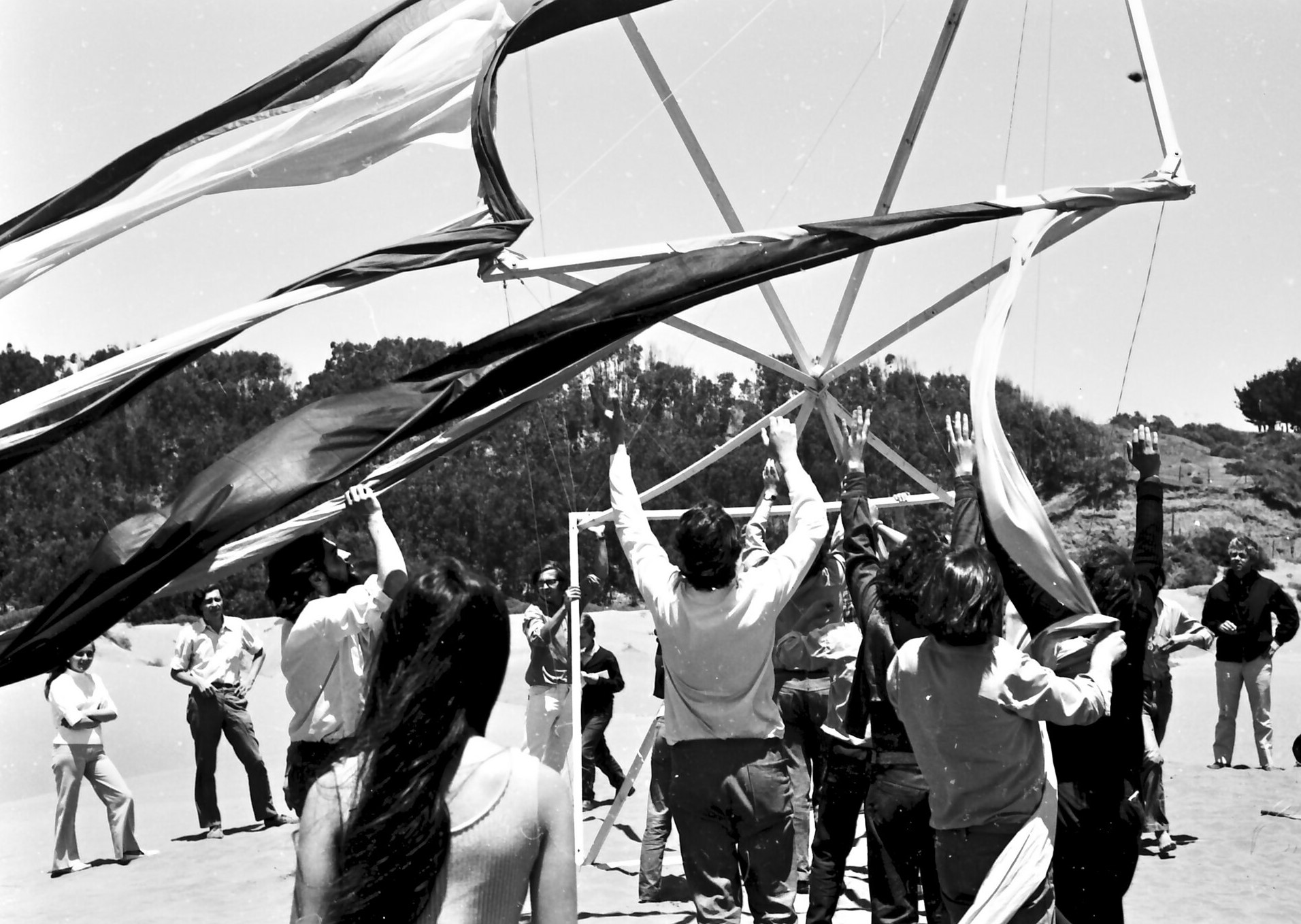
Amereida, also called Open City, took the utopian ideal of the dissolution of art and life to an extreme: It aimed to found our modernity through the creation of a city on the periphery of Eurocentrism and the Latin American urban centers themselves. The latter, having been laid out according to the law of Indies, were marked by the colonial structures that indeed define cities throughout the southern continent. I use the pronoun our to talk about a modernity forged by the case studies I present below. These begin to sketch a genealogy for the region and manifest a desire to foreground these projects as tethered to their geographical contexts.
Open City transcended the idea of a building without walls from within the poetics of a city without boundaries. This city was open because all professions could be part, and all of them would participate in the education and practicing of arts and crafts, as well as in the practice of architecture, as members of Open City had close ties with the Valparaíso School of Architecture (1970-present). Here, we witness not a school open to the city but the creation of the city as a school. It was a city raised with the hands of its own citizens, students, and teachers. Housewives, philosophers, carpenters, and even passersby would integrate into this project where art and life would merge. In using learning spaces and processes as a catalyst for social relationships, ordinary inhabitants would at the same time form an institutional teaching body. Bringing collective life closer to education, or education to life, was the basis of a pedagogical structure that would become an experimental project. This approach to reality did not involve—as one might think—the traditional teaching of the trade of architecture. On the contrary, this project would lead to plastic explorations and playful processes where art, architecture, and poetry would dissolve.
An example of this is the work of Manuel Casanueva, who with his Body Culture Course (Curso de Cultura del Cuerpo) had students hold tournaments where the players became balls, using playfulness to transform and animate the game. The balls were ephemeral structures that people inhabited to move on a soccer field without perimeters. These tournaments acquired many forms, and made the inhabited territory a game board to build a city from their own rules. Bringing architecture closer to the landscape and the body was a way of developing a testing praxis, stimulating knowledge through playful practices based on forms built with light materials that only existed as a pedagogical action. The architecture was built while it simultaneously appeared and disappeared in a performative act inescapably linked to learning.8
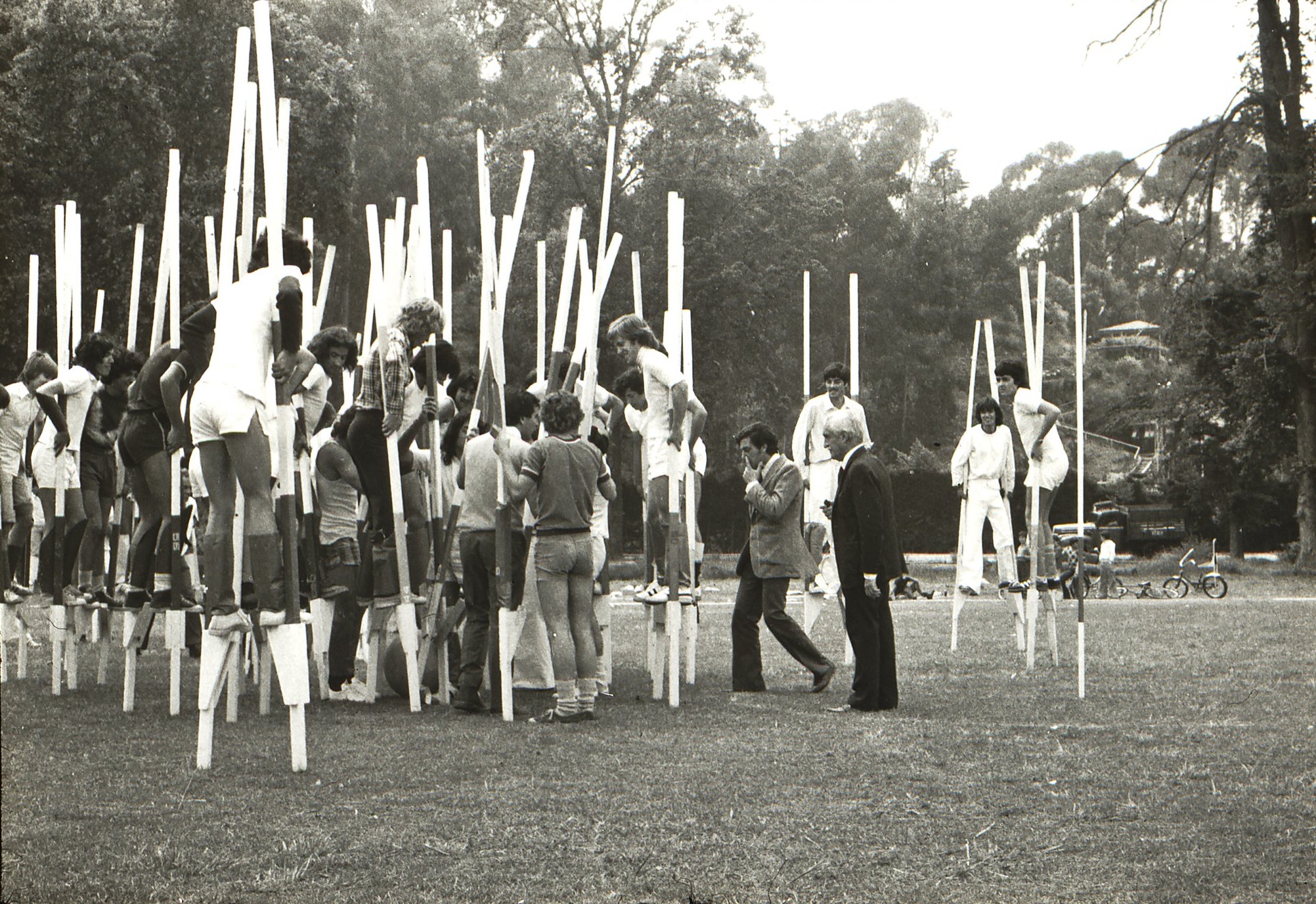

Open City is the evidence of a system functioning built from the construction of a model,9 raising utopias from a speculative materialization. This experimental model has been fertile if we consider how it has multiplied in many other educational practices related to the intervention of the territory. The project of Amereida has been influential on many architecture schools in Chile and South America which promote the consolidation of a local identity. Globally, Open City has been an object of study given that its pedagogical practices have contributed to the invention of a modernity in the South of the continent, predicated on a Latin American avant-garde. Although Amereida built learning spaces under the collective act of founding a city, throughout the 20th century in Latin America, you can find many other artistic proposals for education outside the walls, which are very valuable for the formulation of the Naked School.
A primary example is Joaquín Torres García's Escuela del Sur (1943-1962), which precedes Open City and its interest in education as a research project determined to map a regional modernity whose models are predicated on the local culture of place. Later, movements such as Brazilian neo-concretism—a contemporary of Open City—would also depart from the experience of the body as a collective construction coupled with the learning spaces of the built environment. That is to say, from south to north a body of work has been developed on the pedagogical potential of art, finding in the work of artists such as Lygia Clark (Brazil), Claudio Perna (Venezuela) and Tania Bruguera (Cuba) a series of examples of independent and experimental learning practices linked to formal educational spaces.
Integrated to her research through teaching exercises using participatory strategies, dialogues with her context and deep reflections, each of these artists developed a work that blurs the boundaries between a work of art and an educational project; between a single authorship and collective creation; between body, space, and territorial relationships. In the work of these artists, beyond the production of objects, relationship systems catalyze the transfer of experiences and knowledge. Indeed, what we know today as artistic social practices and participatory art are relational models that generally converge or derive from pedagogical theory. The proliferation of artistic social practices in Latin America is the naked answer to our economic, political, and social realities; it is associated with the fluidity of the encounter between the individual and the collective, the flexible dynamics between which order and chaos are articulated in an organic process, as well as the imagination to solve our own crises.
IV
In this text I have moved from the student's voice to the teacher's voice, first because this has been the way I have experienced education, and second, because I think that both are roles one should occupy in the education process—the one displaced by the other and vice versa. For the last 20 years, I have spent the same amount of time being a student as being an educator, and I can say that I have learned more from teaching than from studying. In other words, I have learned more from the students than from the professors themselves. Early on I understood that I had to teach to learn. In some way, we all teach while learning, cultivating knowledge is one of the most intrinsic conditions of our human nature. Unlike animals, that base their survival on instinct, our evolution is based on human rapport and communication where learning is always taking place.
My education has put me in a privileged position to be able to assess contrasting models—models that generally have a lot to learn from each other and whose analysis can also lead to many discussions. The debate on public and private education deserves its own text, one that would articulate political systems with pedagogical structures. But my reflections on education in art and architecture here become relevant insofar as they are the trigger for the ideas that structure this text. They concern the spatial analogies proposed by the Naked School, and the opportunity offered by the idea of a project that is also a strategy to be able to get out of the hermetism of its logic.
Pedagogical models in art and architecture are similar. There is a system in which individual or collective work is followed by critiques or reviews where teachers and guests comment on the work of the students. The main difference is that in art schools research processes are mainly presented in executed works while in architecture this is realized through projects that are not going to be executed. It was precisely this gap between conceptualization and realization that sparked my interest in the educational demands that characterize art studio practices. The abstract rhythms of the School of Architecture: The planning, the photomontages, and the classroom discussions of hypothetical projects wore me down. This sparked my interest in using the possibilities of art to materialize ideas through installations in the classroom. However, now I find myself in an art school where, though I am asked to install an ideally finished work in the exhibition spaces of the institution, given the architectural, social, and educational nature of my work, I find myself presenting my project with photomontages and planimetries to generate class discussions about hypothetical works that are expected to be developed outside the classroom.
Although my inquiry into the pedagogy of artistic practices began with the interest in bringing the architectural idea closer to the reality of its construction, this research progressively opened new problems and opportunities that awoke from the contexts in which my works were to be inserted. The immediate context, outside the place of learning, became the matter that defined the tectonic properties of the work: from its implantation in the place to the relations with the communities with which it worked. This interest in site-specificity, the built environment, and the social had led me towards a practice of ephemeral architectures that became performative, realized through collective gestures stimulated by the reality of a country in crisis. This is how our first educational projects outside the institution arose, working with my students from the School of Architecture of the Universidad Central de Venezuela (FAU-UCV) inside and outside the University campus.
In Dispositivos para el habitar (Devices to Inhabit) (2013), we worked in the community of Barrio Nuevo—a small favela in the Chacao municipality of Caracas. Alongside students in this new studio course, we sustained the approach of site-specific art installations while altering the subject to the construction of useful devices for domestic living. We developed projects for specific families and built the projects inside of their homes. The projects constituted a series of low-cost and systematic design strategies so that they could be replicated by the community. The students worked individually with a specific family in the design of pieces that responded to the needs of each home.
Inequity and social fractures, as well as the relationships between totalitarianism and polarization, were topics that began to expand, seeking to occupy a place in the discussion from within the possibilities of education. From within this critical teaching, conceived and produced within crisis, my practice has evolved vis-à-vis the social and political aspects of the place. In Venezuela, the absence of civic and democratic spaces has led us to create alternative models of participation and activation of the inoperative public space.
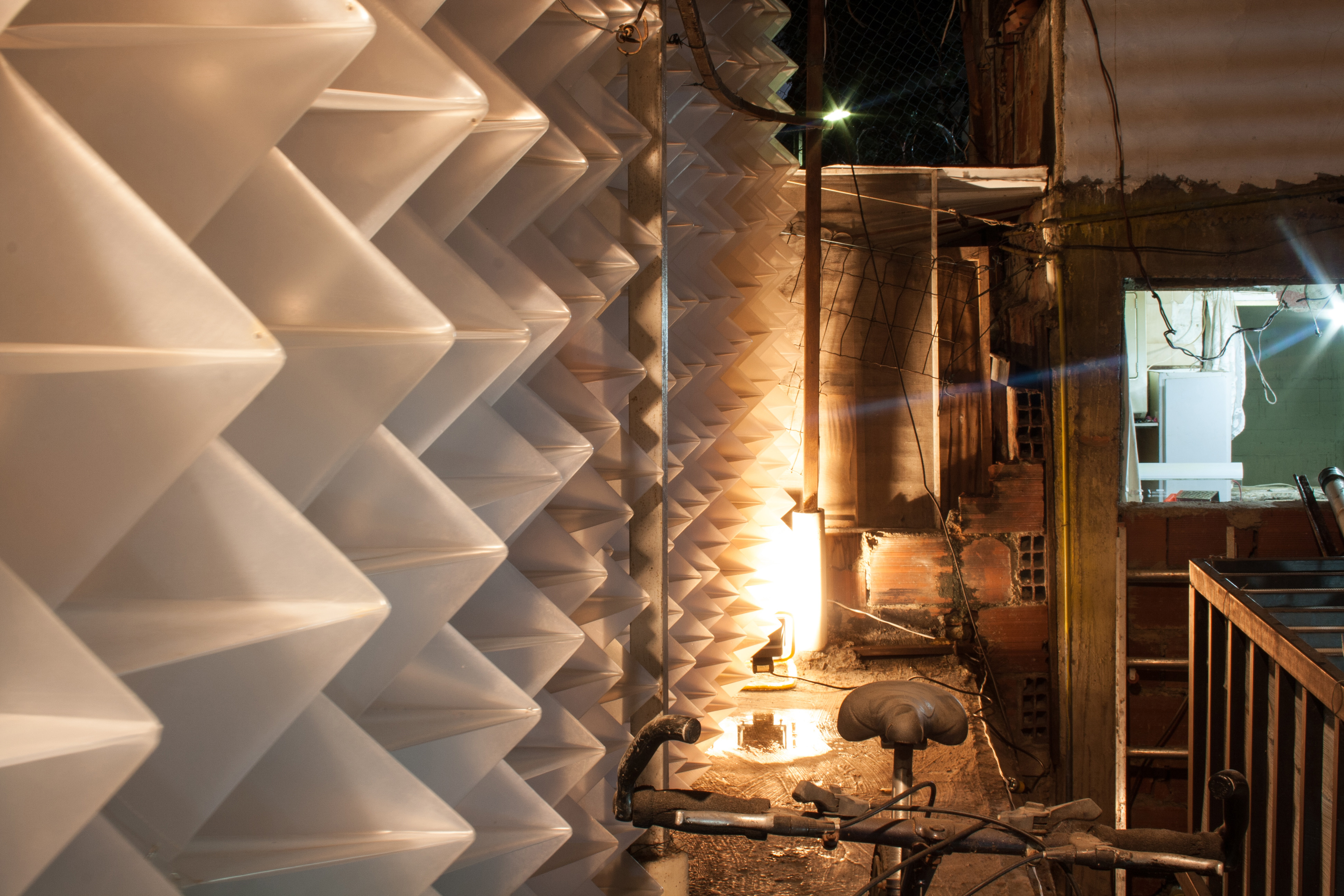


This is how my first public art projects, in collaboration with my students, were developed. First inside the University City of Caracas—the campus that houses the Universidad Central—and later throughout the city itself. Crossing from east to west with the participation of people from diverse communities, we completed projects that aspired to contribute to the restructuring of the city’s social fabric. Works such as Biblioteca Abierta (2013), Traslaciones (2014), and Area (2014), were born from an interest in creating new dialogues between citizens in public spaces. The goal was to build ephemeral places that could facilitate reflections on our reality: departing from our bodies and the things that surround us. These were spaces that were built on the experience of the participants and that addressed an external audience through images that aspired to communicate our resilience and faith in the political possibilities of these aesthetic poetics.
In Biblioteca Abierta, we displayed thousands of books on the ground of the Plaza Cubierta (Covered Plaza) of the Universidad Central de Venezuela (UCV) in the context of a national strike of public universities. The books were a gift from our academic community that people could take freely. Its purpose was to reveal the value of the academy, by taking its knowledge production to the public space. It was a gesture that sought to incorporate society into the university’s conflict, and to add more people to the struggle for the revindication of the conditions of the Venezuelan universities. This installation went viral across social media and made the national news. Because of this, the images of the project were as important as the interactions it inspired, and the aim of engaging more people into our protest was achieved. This work became a systematic project that we later repeated by distributing books in other communities. Meanwhile, in other projects, we began to rely directly on the participation of people by using our bodies to build experiences, social spaces, and political discourses.




In Area, people gathered beneath a long ribbon that was held by all with the aim of building a common area in Plaza Caracas—an emblematic square located in the government district of the capital city. This is an urban space marked by the segregation of a social polarization used as the political campaign of the Government during the Chavismo. That day, there was a storm, yet nobody abandoned the action. Only the participants were left in the square, in the middle of an atmosphere where the rain demanded resilience. All of these projects have been developed by posting open calls, which have lived in the public sphere through their processes and subsequent results. These projects have sought to make participation, and the collective gesture, a language for the encounter of both experience and form.
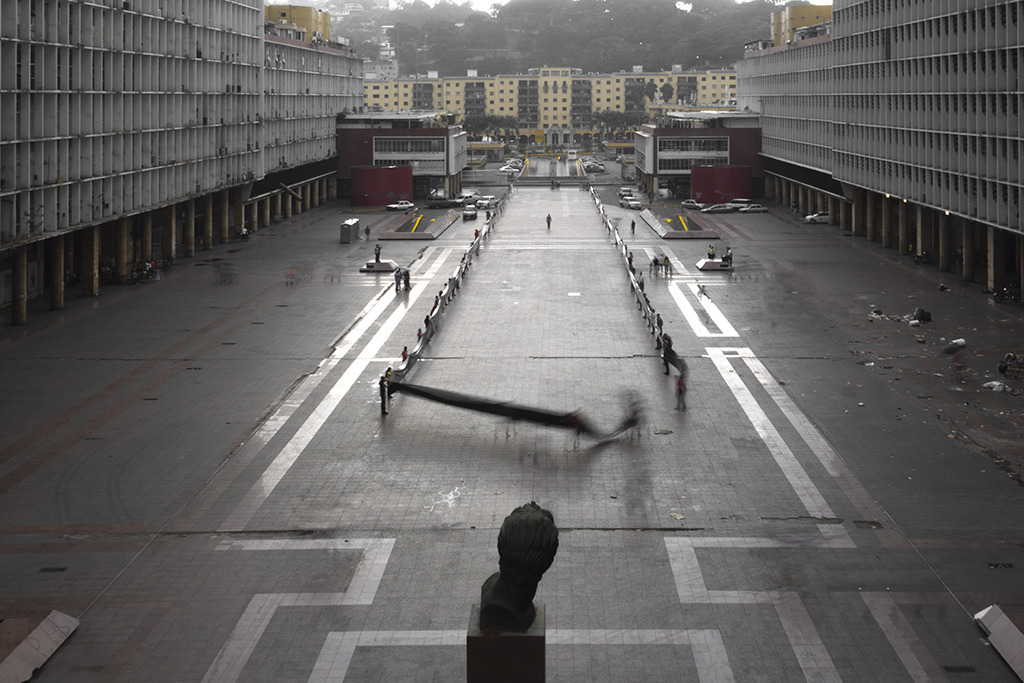



These projects also embodied a transition from my teaching practice to my artistic practice, as well as an increased interest in the field of social art and audiovisual media. The collaboration, coordination, experimentation, and improvisation involved in this work with students and communities led to experimental proposals in the public space; and later, through photography and video, these explorations developed into new dialogues realized in virtual space, in social media networks and other forms of digital communication that generated unexpected approaches to the public sphere. My teaching practice was transformed into my own work, which quickly found a place to live in the art world—an experience that then transformed my educational practice again.
The artwork as a formative project proposes complex models of authorship that come from collective construction, but also depend on the nature of the pedagogical models in question. Beyond the tangible object that results from these practices, and even beyond the intangible experience, it is the pedagogical structure from where the works are born.
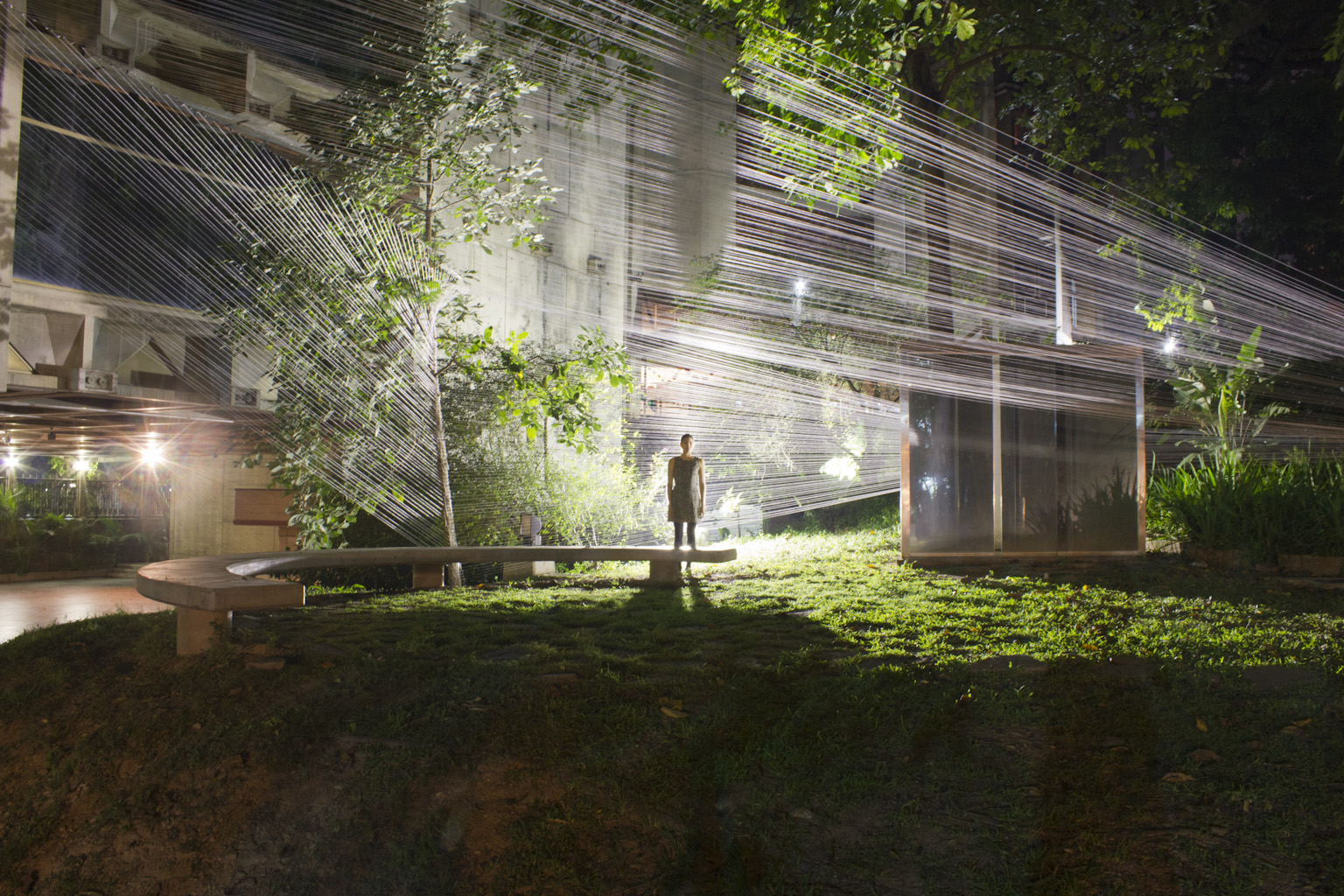


Within the thesis of the work of art as a formative project, the methodology becomes the substance of the work. More than a regulatory structure, these are processes that trigger knowledge—the strategy with which Joseph Jacotot communicates with his students without speaking the same language and the emancipation of the master as described by Jacques Rancière.10 The steps to make the work possible are the basis of an artistic model that has an interest in the processes; put otherwise, the method becomes enlisted as support for the creation of every form. I use the word “formative” rather than “educational” for two reasons. First, “educational” shifts the focus towards the instrumental role of teaching instead of learning. Secondly, a “formative project” is capable of drawing meaning from its learning content and formal component, and from the progressive condition of the construction of the form.
Consider the work CasaCuerpo (2014), a formative project realized with architecture students from my studio courses as a professor at ‘Taller X’ FAU-UCV. The proposal was a pedagogical model for first year students of the School of Architecture, where the objective of the first class was to “design a house from and for your own body.” This project sought out to build new temporal relationships between body and space. The aim was to inhabit spaces that move with us instead of traversing static places. It was research into the structural aspects of our movements. The pieces that made up CasaCuerpo were developed in the workshop setting throughout the semester and were the result of the exchange and the coexistence of a group of students working on individual proposals, sharing the same objective. Here, knowledge was obtained through the empirical processes freely developed within this playing field made up of precise variables according to which students try to discover in doing. The work is an academic exercise developed through a concept that structures research and generates form that stimulates differences. Each proposal that results from this course is different, but all contribute a piece to the visual alphabet of a series of body architectures. Here, the concept, rather than the idea, is a strategy to generate new possibilities, and its content opens up to the infinite imagination from a common exploration.
More recently, I have started to develop the pedagogical aims of the studio courses within the collective performances in public spaces, thus combining the formative aspects and the performative condition in the same works. The latest of these projects is titled Monumentos Horizontales (Horizontal Monuments) (2020), it was a collective performance that took place in Guadalajara, Mexico, and which, without being associated to any academic program, became an open classroom in public space. The project began with the placement of a 1:1 scale replica of the obelisk located in Plaza Juárez in front of its vertical namesake. The copy of the monument was installed on the ground, made with PVC pipes and elastic fabric, making this monument a malleable object to manipulate with the body. We asked ourselves: and now what? This question sparked a series of academic discussions on art, architecture and urban planning in a completely non-academic environment, conversations that became actions. We measured the obelisk using the body, we inhabited it, transformed it into a shelter, turned it into a playground; we moved, rotated, and dismantled it.
Students and professors, together with members of the community, met to give voice and form to the ideas that were born from the transformation of this object, turning the obelisk into an assembly—a forum to discuss its destiny. In the past, I have used architecture classes to create performance objects as a political act, while in other instances the class has produced props to generate discussions on politics and architecture. These are pedagogical proposals that depend on a collective structure of collaboration, discussion, and action. A common practice characteristic of contexts in crisis is suggested by Hélio Oiticica’s response to situations of adversity. In an effort to be mindful of this Southern genealogy alluded to above, we can cite Brazilian educator Paulo Freire, known widely for the ideas developed in his oft-cited works Pedagogy of the Oppressed (1968) and Pedagogy of Freedom (1998): “To teach is not to transfer knowledge but to create the possibilities for the production or construction of knowledge.”
The examples of my work parsed above aim to demonstrate my interest in the possibilities of education as an artistic practice while at the same time, highlight the challenges of this project. This is also what is expected of an MFA thesis: a reflection on my work and experience in Art School. Through the latter, I discovered art as a formative project.
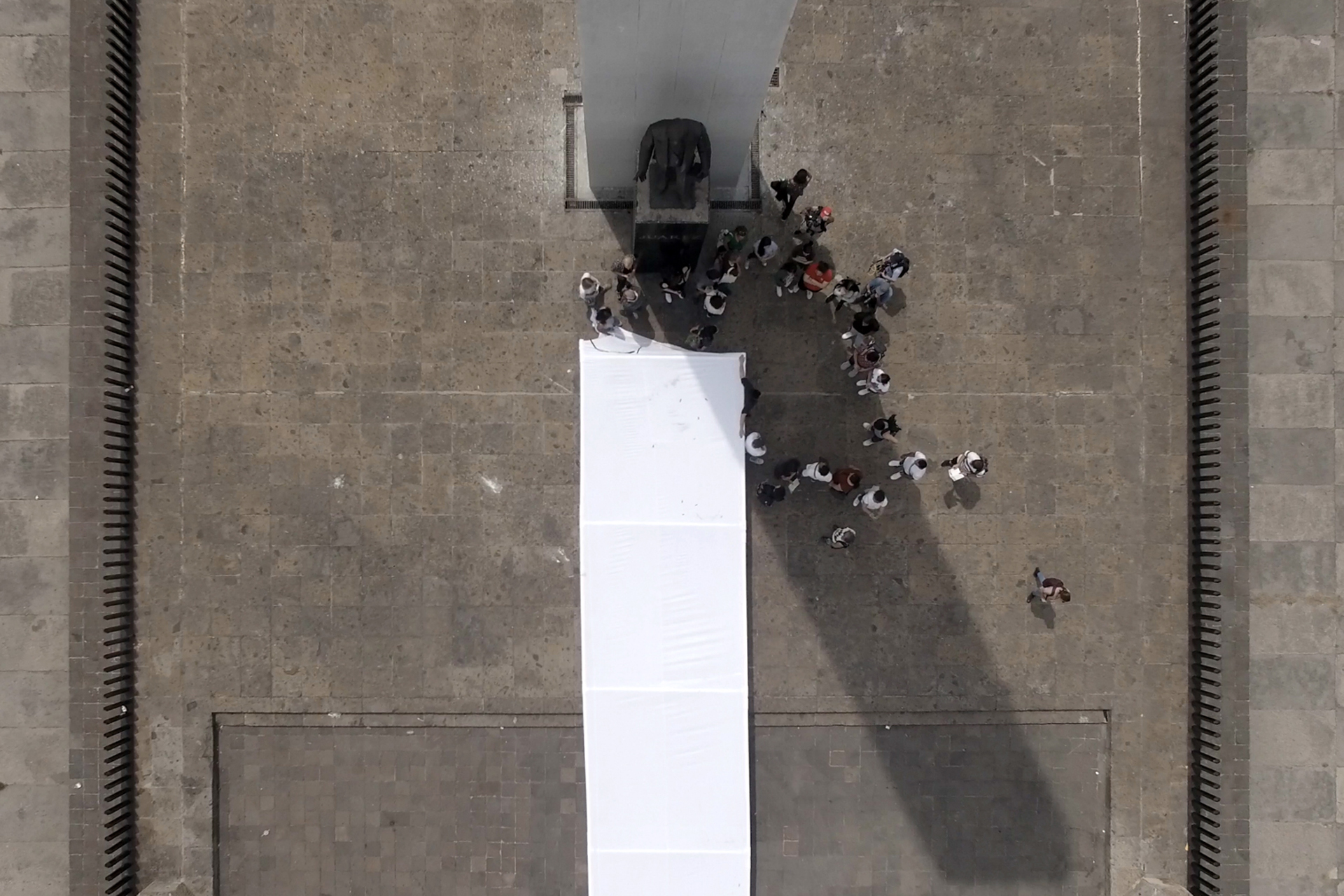



Teaching architecture led me to an artistic practice that opened the doors to the “professional” artistic world, and that professional experience gave me the opportunity to be awarded an art school scholarship—all while wanting to be a teacher for being an artist.
Apparently, I have inverted the process—and the values—but I have tried to make that an opportunity to attempt other dynamics and to generate a body of work related to education. Studying in an art school led me to inhabit my own research object. Beyond all the knowledge acquired in classes, talks, and discussions, the School as school became a lesson in itself. Although my teaching practice in architecture is not transferable to art education, through this text I start mapping references that allow me to open up possibilities and to continue learning. That is why I hope to continue using these spaces to develop my artistic practice. I need them to produce, and I cannot conceive of producing if there is not an exchange of experiences that translate into knowledge.
Artworks, as a system of relations, are based on an exchange capable of taking many forms, which in the case of schools is enhanced by being linked to the production of knowledge. The ability to distribute and multiply this knowledge is one of the greatest attributes of education. Building a community to support these exchanges is the other value that accompanies education. Hence, many artists have used the construction of schools as an artistic practice, and the artistic practice has placed profound interest in education as a production space.
V
While museums are adorned with classic ornaments on the facades or designed by star architects, we have to free art schools by bringing them closer to their contexts. In order to discover what is truly substantial, education must be naked. Its spaces can only be open places, empty spaces that are inhabited and sustained by the possibilities of learning. Art schools must depurate education to find the necessary autonomy11 to create new possible systems; and in turn, go outside to approach reality from this transformation. We speak of learning structures that can affect and nurture its contexts without collapsing, as well as generating a contribution to them in return. If schools require physical buildings and walls, academics must be reduced to their structural support—a structural support predicated on experimentation, transformation and in constant exchange with its milieu.
The Naked School, more than a metaphor, is a prototype, an architectural proposal to question the way in which we learn and teach today and, hopefully, to help us map new possibilities and learning models.
Currently, there is an abundance of art schools and therefore a wealth of artists. If artists today are born from these schools, and if art schools themselves can become works of art, then there would be nothing more impactful in the art world than a rethinking of education. By tearing down the walls of our schools, the art world would be able to transcend from its pre-existing confines and be introduced into the world at large.
